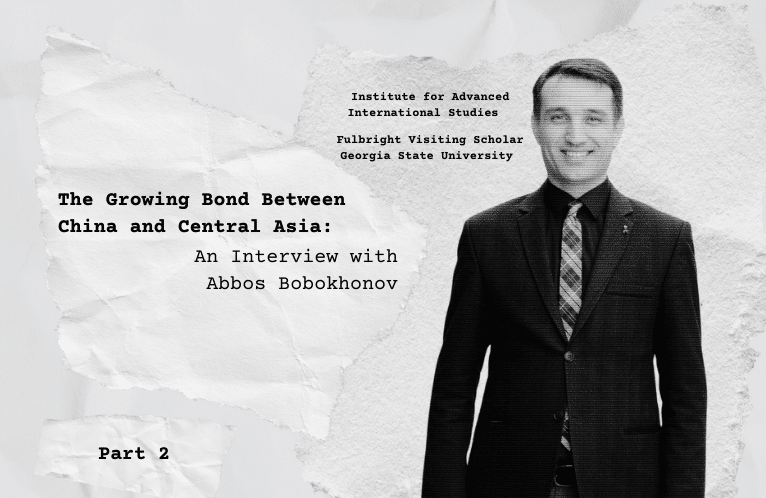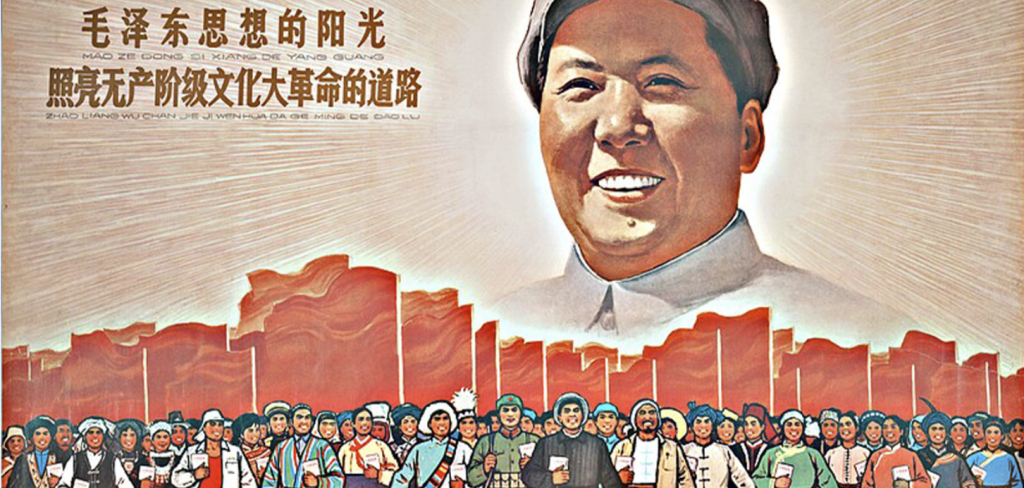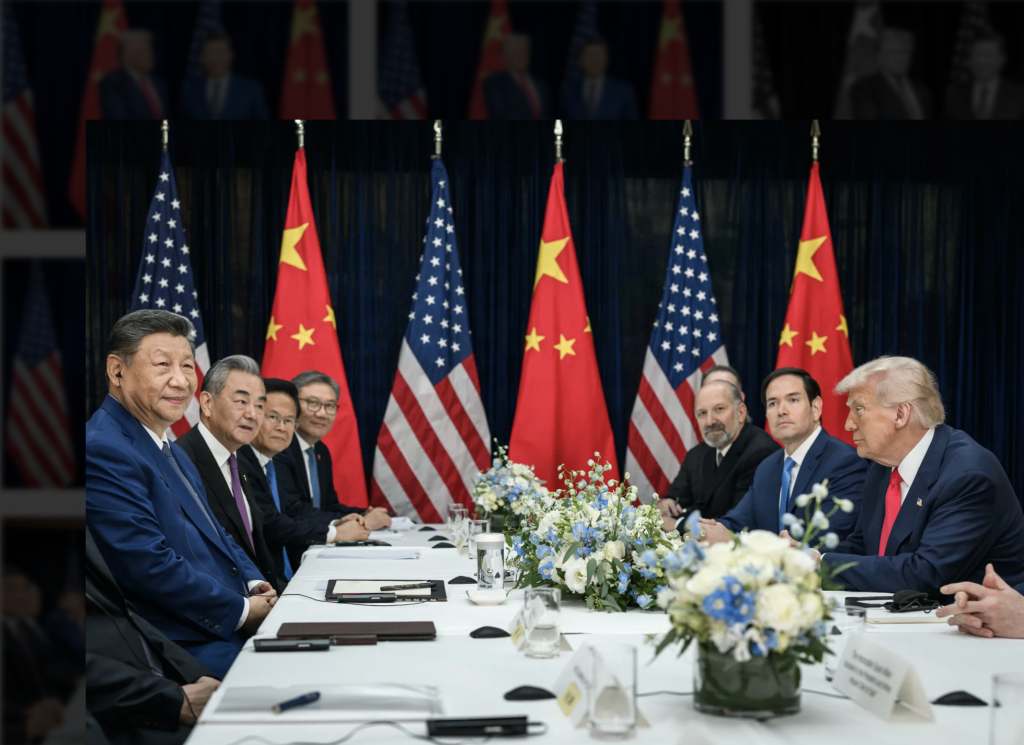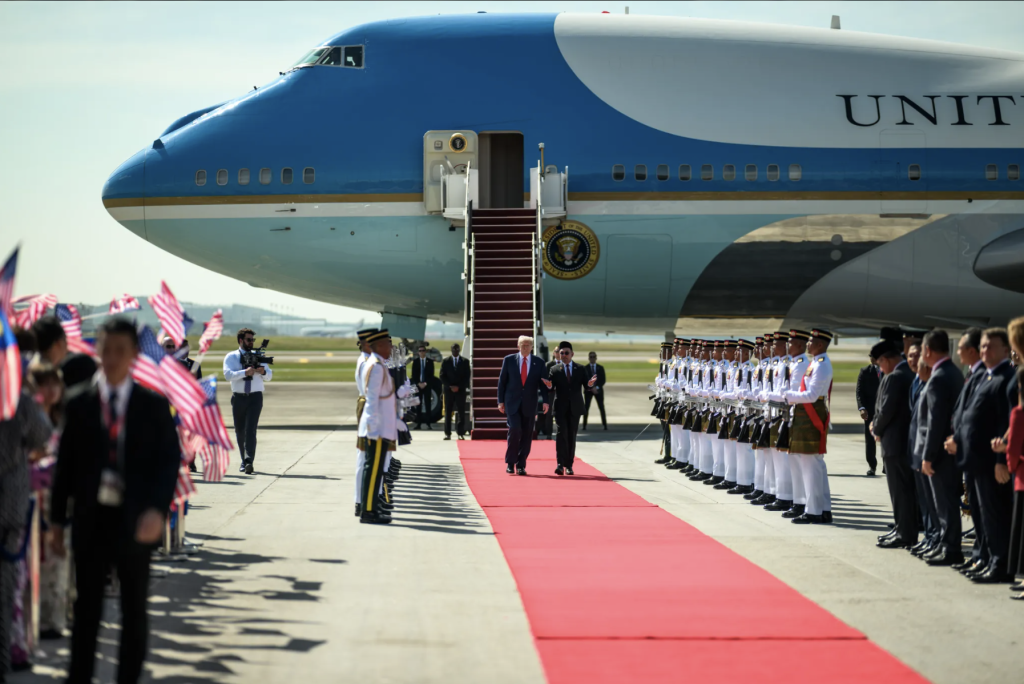The Growing Bond Between China and Central Asia: An Interview with Abbos Bobokhonov, Part 2
- Interviews
 Miranda Wilson
Miranda Wilson- 10/15/2024
- 0

While The Monitor’s main focus is usually the U.S.-China relationship, we recognize the growing importance of both China and the United States’ shifting alliances. One such alliance is the growing relationship between China and Central Asia.
We sit down with Dr. Abbos Bobokhonov to discuss China’s strategy towards the region. Recently, China has poured diplomatic resources into strengthening its presence and positive perception in Central Asia, from funding infrastructure projects to promoting its media outlets. China has taken a unique soft power approach to win Central Asia over; a necessary strategy since, as Dr. Bobokhonov notes, positive perceptions of China in the region are relatively low.
Another important factor in China-Central Asian relations is the looming shadow of Russian influence. However, Russia’s war with Ukraine has distracted it from other geopolitical relationships, and its neglect of Central Asia has left room for China to fill the gap. And because China is one of the few powers supporting Russia’s conquest of Ukraine, there is nothing Russia can say about China’s growing influence without risking losing its support.
In this two-part interview, we cover these complicated relationships as well as the Belt and Road Initiative, the Asian Infrastructure Investment Bank, and Dr. Bobokhonov’s recent visit to Xinjiang.
Abbos Bobokhonov holds a PhD in Political Science from the University of World Economy and Diplomacy. He received his Master’s degree in Theory and History of International Relations from the National University of Uzbekistan. He is a specialist with more than 15 years of experience in think tanks in Uzbekistan. Currently, Dr. Bobokhonov serves as the Head of the Indo-Pacific Studies Center (China Studies Program) at the Institute for Advanced International Studies at UWED. He has a great interest in China’s foreign and regional policy, including SCO, researching China’s policy in Central Asia, China’s “soft power” and media policy in Central Asia, and Uzbekistan-China bilateral relations. This fall, he is serving as a Fulbright visiting scholar at Georgia State University.
Miranda Wilson: Your research also pertains to the Asian Infrastructure Investment Bank, which is relatively new. How can we judge the success of the AIIB so far? What is China’s role?
Abbos Bobokhonov: The Asian Infrastructure Investment Bank (AIIB) officially started operations in 2016. The bank was established at a time when there was a substantial need for implementing infrastructure projects, particularly in the Asian region. The AIIB serves as a primary financial and, to some extent, reputational instrument for China. From 2016 to 2024, the bank has financed a total of 284 projects (with a total allocated amount of $54.5 billion), out of which 24 are attributed to Central Asian countries amounting to a total of $4.42 billion. The bank has a membership of 109 countries, including key developing economies in Europe and Asia as well as five G7 countries.
The concept of establishing the AIIB in China is also linked to enhancing China’s positive image as a responsible global leader and global player in economics. The creation of the Bank has been viewed by experts as China’s financial contribution to infrastructure development worldwide, particularly in Asia.
The attractiveness of the Bank is underscored by several factors: 1) robust financial capacity with a surmised capital of $100 billion; 2) a focus on infrastructure development; 3) openness to states; 4) absence of “political conditions” in loan provision and relatively short project review periods; Plus, rapid membership growth, nearly doubling from the start (57 to 109). This surpasses the EBRD (54) and ADB (67), and ranks second after the World Bank (188) in terms of significant banks.
Contrary to experts’ assumptions that the AIIB would face negative perceptions due to competition with other international financial institutions, such as the World Bank and ADB, the Bank’s actions over time have shown a positive trend and demonstrated China’s “soft power.” International experts also positively assess the AIIB’s highly “flexible” banking policies. Notably, during the pandemic, the AIIB established a special $10 billion fund to combat the pandemic’s consequences and support healthcare, continuing its investments in developing countries.
Interestingly, despite occasional diplomatic tensions and conflicting positions with China, India, while not participating in the BRI, became a founding member of the AIIB. India is one of the three major shareholders of the bank, holds an 8.37% stake. It is also one of the main beneficiaries of the bank, receiving significant loans from the Bank.
The AIIB aligns with the goals of infrastructure development in Asia, deepening regional and international cooperation, advancing infrastructure, and enhancing regional integration with Central Asian countries. Uzbekistan was among the first countries to support the institute and took place among the founding countries.
The AIIB has become a strategic partner for the country in large-scale projects aimed at promoting socio-economic and infrastructural development. In particular, between 2017-2022, over 15 meetings involving relevant Uzbekistan governmental bodies and Bank representatives were organized, leading to mutual agreements on establishing a close cooperative relationship. Over the past 7 years of AIIB operations, Uzbekistan has become one of the countries where the highest number of projects have been financed, with credit funds allocated to more than 10 projects, totaling $2.5 billion from 2019 to 2024.
However, according to Western experts, by establishing and actively promoting the AIIB, Beijing aims to create a China-centric economic order. They argue the AIIB operates as a business rather than a form of aid, as loans are provided on commercial terms. China intends to transform the AIIB into a globally influential financial institution, through which it can assert itself as the world’s leading economic power.
Despite China’s assertions that the AIIB is an independent structure, certain facts indicate China’s strong position within the Bank. For example, the AIIB’s headquarters are in Beijing, the Bank’s president is Chinese, and many key managerial positions are held by Chinese specialists. China’s shares of surmised capital is 26.5%, it’s granting veto power over any project, and the distribution of votes. Taken together, these factors provide Beijing with significant control over the Bank’s operations. In this regard, some Japanese analysts have referred to the AIIB as “China’s internal bank.”
MW: Based on your research, how is China using media to shape its image in Central Asia?
AB: I think that the media is one of the most critical tools driving Beijing’s “soft power.” Since the early 21st century, following the “policy of openness and reform,” China has gradually shifted from a passive foreign policy under Deng Xiaoping to a progressive, active foreign policy under the leadership of first Hu Jintao and then today’s Xi Jinping.
A pivotal moment in the development of Chinese media was the Five-Year Cultural Development Plan adopted in 2006, which dedicated an entire chapter to the strategy of promoting Chinese culture on a global level through the support of mass media. At that time, the Chinese government allocated $6.6 billion for the modernization of its media. This goal aimed to counter distorted information disseminated in Western media and shape a positive image of China overseas.
Later, Chinese President Xi Jinping stated that China needed to develop an “international voice” to match its national power and global status. Framing the issue in this light necessitated a fundamental reassessment of the goals and tasks of the media, orienting the strategic direction towards creating world-class media and enhancing “China’s voice” on the international stage. From this period onwards, Chinese media actively began to venture onto the global stage.
It’s important to note that unlike Western counterparts, Chinese media is directly funded by the state. The key political institution implementing the country’s media strategy is the Information Office of the State Council of China, and in recent years, the Propaganda Department of the Communist Party of China.
To shape a positive image of the country abroad through an “independent” information space, China has taken a serious step. Particularly, there has been an expansion of the country’s media influence in strategic regions important to China. Effective measures have included expanding the country’s media influence in the Middle East, Africa, and Central Asia. Where China invests in the development of local media to counter the distorted representations of China by Western media and improve the positive image and knowledge of China and its culture in these countries.
Despite the high-level development of politico-economic relations between China and Central Asian countries, relations with Central Asian media are considered the least developed. In the media space, China is more present in Russia, primarily in Kazakhstan and Kyrgyzstan in the Central Asian region, and in recent years, in Uzbekistan. Among Chinese media outlets, Xinhua News Agency, People’s Daily, China Radio International, and Central China Television (CGTN) are more active in Central Asia.
China considers Kazakhstan important for the widespread dissemination of China’s information policy in the region. For instance, Kazakhs have access to over 40 Chinese-language television channels, including Xinhua News Agency broadcast in Russian language, which enables them to provide information to a wider audience in Kazakhstan. Moreover, since September 2021, the online version of the People’s Daily has become available in Kazakh language.
China’s entry into Kazakhstan’s information space is a significant step demonstrating Beijing’s strategic intentions to strengthen its role and positive image, as well as to further expand the coverage of its media in the country. Previously, many experts criticized China for its limited influence in the region due to language barriers. Taking this into account, China has decided to enter the Central Asia market in the language of this country and promote Chinese policies in Kazakhstan.
On the other hand, this initiative represents an attempt by China to alleviate growing anti-Chinese sentiments in Kazakhstan. Protests in 2010 and 2016 in Kazakhstan indicate a low level of trust regarding China’s policies in the country and the region as a whole. In this context, the launch of the main Chinese government newspaper in the Kazakh language and the overall presence of Chinese media, are aimed at conveying more positive information about China and its culture. Thereby reducing tensions and reshaping a positive image of the country among the officials and the population. Alongside this, Beijing has initiated various forums for media cooperation among the SCO and CIS countries, as well as individual press tours inviting prominent journalists and specialists from various media outlets worldwide, including Central Asia.
However, considering Russia’s significant informational and cultural influence, Beijing currently possesses modest capabilities and competitiveness in the development of Chinese media, distribution. Consequently, the media sector remains one of the least developed areas, but the measures being taken indicate that Beijing will strengthen this tool in the coming years.
In Uzbekistan’s media landscape, a noticeable Chinese presence has also begun to emerge. This trend became particularly evident after 2016 when the country’s new leadership fostered openness and freedom across all sectors, including the media. Notably, the local online publication “Podrobno.uz” launched a section titled “Uzbekistan and China: Keys to the Future,” regularly featuring various materials promoting China and highlighting the benefits of cooperation with the country.
Chinese news agencies such as Xinhua, People’s Daily, and Economic Daily all operate in Uzbekistan. CGTN in the Russian language has been included in the cable television lineup since 2022. However, Chinese channels are relatively unknown to the Uzbek audience, mainly attracting individuals who work on China-related issues. Like me as an expert, or China language teachers, businessmen, and so on.
Recognizing this, with the support of the Chinese Embassy in Uzbekistan, the local online publication “Podrobno.uz” annually organizes various contests among the local population, focusing on knowledge about China. Such initiatives are crucial elements in utilizing Chinese “soft power,” and also play a significant role in enhancing China’s image by increasing local awareness of Chinese culture and policies.
In the realm of information diplomacy, Uzbek journalists highlight media tours to China organized with the support of the Chinese embassy in Tashkent. Between 2004 and 2017, 15 such exchanges involving journalists were arranged, including 9 for journalists from Central Asia as a whole.
Journalists note the warm reception extended to media representatives during these tours and reported a more positive perception of Beijing upon their return. They did not feel pressured by the hosts to report on certain topics. Typically, the Chinese side “suggests” participants cover events in a positive light and generally write favorably about China after such tours.
However, the language barrier hindered journalists from conducting interviews with local residents or reading local news in China. Overall, China’s development strategy places a significant emphasis on media, aiming to enhance the country’s position and propagate China’s philosophical outlook and culture.
MW: This year you were invited on a tour of Xinjiang. What was your experience there?
AB: I went on a tour in of Xinjiang Uygur Autonomous Region (XUAR) in July of this year, which was organized by the Embassy of China in Uzbekistan. The purpose was to familiarize the Uzbek delegation with the XUAR, including the development of specific regions and the culture in Xinjiang, aiming to create a positive impression among Uzbek society by highlighting positive information about Xinjiang.
During the trip to Xinjiang, visits were made to more than 20 places, It’s Urumqi, Gulja, and Kashgar. The program was meticulously crafted. On the one hand, they showcased the autonomous region in a positive light. On the other hand, they left little room to internally explore the region, thus being unable to understand the real situation in Xinjiang.
Despite China’s substantial assistance and significant investments in Central Asian countries, public perception of China in Central Asia remains unchanged, predominantly negative in terms of Xinjiang. This is primarily due to the dissemination of information about labor camps and the persecution of Uyghur Muslims in Xinjiang. In response, the Chinese side places priority on cooperation with Uzbekistan’s media and experts. China frequently organizes press tours and these trips for experts.
During the trip to XUAR, organizers led participants along a pre-planned route, excluding all possibilities of deviating from the agenda. Following each event, organizers recommended and urged participants to publish information about Xinjiang, mostly in a positive context.
So as far as I know, the participants on this tour published articles about what they saw in Xinjiang, the traditions of the region, city development, and things they observed. The China side showed a key interest in showcasing changes in Xinjiang over recent years and shaping a positive perception among participants.
At the Urban Planning Museum in Urumqi, participants were briefed on the city’s development history and contemporary planning, with a focus on massive architectural projects and infrastructural initiatives. A visit to a museum showcased materials on combating terrorism and radicalization in Xinjiang. According to museum personnel, there have been no terrorist attacks in XUAR over the past 8 years. It’s good for the region because Chinese missions have shown positive results.
During a meeting, local government officials expressed a desire for the delegation to have an objective understanding of Xinjiang. Consequently, the China side primarily invites representatives from the media and expert scholars who are capable of accurately conveying objective and real circumstances in Xinjiang.
Chinese representatives also discussed plans to launch a joint television program between Xinjiang and Central Asian countries, specializing in highlighting cultural and humanitarian connections. China views Central Asia as a key focal point contributing to the economic development of the Xinjiang Uygur Autonomous Region. In recent years, Xinjiang has emerged as a dynamically developing region of China, partly due to increasing its trade with Central Asian countries. The Xinjiang accounts for over 70% of China’s total trade. The Chinese perspective holds that the financial-economic interdependence and investment ties of the region’s countries will play a pivotal role in shaping the stances of local leaders regarding the Uyghur issue.
In this context, the government of the XUAR places significant emphasis on the implementation of the China-Kyrgyzstan-Uzbekistan Railway Project, envisioning it as a modern bridge uniting our people. Economically, this project accelerates the integration of the Western part of China with Central Asian countries, allowing China to access markets in Central Asia and further. Consequently, Xinjiang will become a crucial transport hub connecting China with Central Asia, propelling Xinjiang into a new phase of economic development.
Moreover, they took us on internal visits to several business entities such as an automobile company GAC, a dried fruit producer Jiangguoguo, and a free-trade zone, intending to showcase not only business development, improving the living standards for the population, but also their products to regional representatives. They like to demonstrate this economic potential, so the participants spread this information to the Central Asian countries. Additionally, the event included trips to various far regions of Xinjiang where participants were primarily acquainted with the local culture, tourist attractions, and the development of joint businesses.
Significantly, the China side, considering that participants from Muslim countries were included in the program, arranged visits to mosques, in the ancient city of Kashgar. Participants visited the Id Kah Mosque, considered the largest mosque in China.
However, participants were not allowed to interact with the local population without accompanying officials from the local government. Overall, our delegation’s trip to China was productive and beneficial. Participants witnessed firsthand the situation in the Xinjiang region, the attitudes of the local population, and the state of development in various corners of the region. They also familiarized themselves with the region’s cultural, religious, and educational institutions. The knowledge gained will be invaluable for all participants, inspiring future research and professional endeavors. It was a very amicable visit for me personally.
Read part 1 of the interview here.
Miranda Wilson is a senior at Emory University and contributing editor for the U.S.-China Perception Monitor.
The views expressed in this article represent those of the author(s) and not those of The Carter Center.







